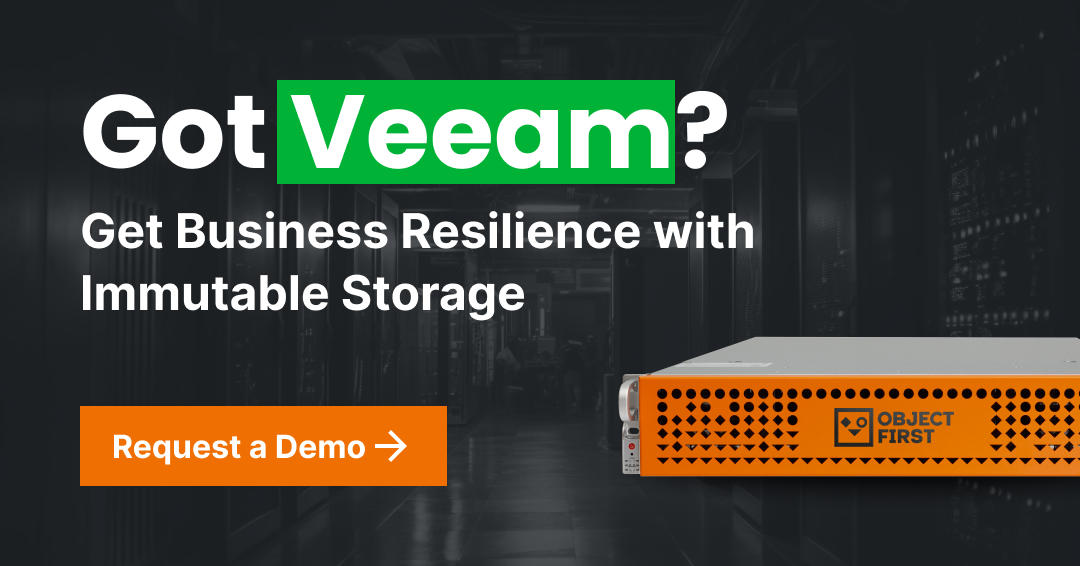Data Resilience: The Complete Guide to Survive Modern Cyber Threats
Most organizations believe their backups will save them when disaster strikes. The truth is that in most ransomware attacks, those backups are the first target. Once attackers corrupt or delete them, recovery becomes impossible without paying a ransom.
This false sense of security is one of the most expensive mistakes a business can make. Backups alone are not enough, especially if they can be altered, accessed, or destroyed through a single compromised account or API call.
That's where data resilience comes in. Done right, it transforms backups from a fragile safety net into an unbreakable recovery lifeline. In the next few minutes, you'll learn what it takes to make that shift and why it's the single most important upgrade your backup strategy will ever get.
Key Takeaways
1. True data resilience starts with storage-level immutability and strict isolation, ensuring backup data remains untouchable even if ransomware or compromised admin accounts gain full production access.
2. Data resilience depends on continuous integrity validation, using automated checksums, test restores, and anomaly detection to guarantee that backups remain clean, consistent, and ready for recovery under real-world attack conditions.
3. A resilient recovery strategy requires an independent, multi-path architecture, allowing systems to be restored without relying on compromised production infrastructure during outages, data breaches, or disasters.
What Is Data Resilience?
Data resilience is the capability of an organization’s systems to ensure uninterrupted access to clean, recoverable data, no matter if the disruption comes from hardware failure, human error, or a targeted cyberattack.
However, true resilience isn’t just “having backups.” It means those backups must be immutable (cannot be altered or deleted), verifiable (integrity is continuously checked), and recoverable under pressure when every second counts.
Simply put, it’s a mindset shift that requires you to design your backup, secure data storage, and recovery architecture assuming a breach will eventually happen.
Why Data Resilience Is Important
Data resilience is the foundation of business continuity in an environment where downtime, ransomware, and silent data loss are constant threats.
Here's why it really matters:
-
Ransomware targets backups first: In 96% of incidents, attackers attempt to corrupt or delete backups before encrypting production. Without immutability, logical isolation, and credential separation, the very systems meant to save you can easily be weaponized against you.
-
Replication without integrity spreads corruption: Copying data that hasn't been validated simply multiplies the problem. Resilience ensures backups are verified and tamper-proof before replication, stopping compromised data from contaminating cloud or offiste backup copies.
-
Downtime costs escalate fast: At over $300K per hour, recovery speed is a financial and operational imperative. Resilient systems are architected to meet strict RTOs and RPOs, even under breach or infrastructure failure.
-
Hybrid environments demand unified protection: With workloads split across on-prem, cloud, or hybrid, resilience creates a single, consistent recovery posture so every data set is equally protected and recoverable.
-
Unverified backups are a liability: Silent corruption, failed jobs, or retention gaps can remain hidden for months. Continuous integrity checks, enforced immutability, and proactive alerts ensure recoverability before disaster strikes.
-
Compliance requires proof, not promises: Regulations like GDPR, HIPAA, and NIS2 mandate demonstrable recoverability within set timeframes. Resilience turns compliance from guesswork into verifiable, audit-ready assurance.
7 Core Principles of Data Resilience
True data resilience results from a system-wide architecture designed to survive failure at any point in the data lifecycle. This requires moving from traditional backup thinking to a Zero Trust, breach-assumed model, where every layer is independently secure, testable, and recoverable.
1. Immutability at the Storage Layer
If backup data can be altered or deleted—even by an administrator—it’s not immutable. Storage-enforced immutability at the hardware or object level locks data against ransomware, misconfigurations, and insider threats, ensuring it remains clean and unchangeable until its retention period expires.
2. Isolation from Production Systems
Ransomware thrives on lateral movement. Data backups must be isolated from production through separate networks, credentials, and access controls so that even if attackers gain full production access, they can’t reach recovery data.
3. Independent Recovery Pathways
A resilient recovery plan does not share infrastructure with production. Backups should be restorable even if hypervisors, authentication services, or cloud control planes are offline, using independent hardware, networks, and credentials.
4. Automated Integrity Verification
Untested backups are a gamble. Regular checksum validation, automated test restores, and real-time alerting for failures or anomalies ensure recovery data is both intact and usable when needed.
5. Policy-Driven Automation
Manual backup management invites errors. Automated policies should govern schedules, retention, immutability windows, and replication timing, enforcing consistency across environments without relying on human intervention.
6. Granular Access Controls
Every user, service, and system should have the least access necessary. Role-based permissions, multi-factor authentication, and protections against deletion (even by privileged accounts) are non-negotiable in a Zero Trust backup design.
7. Multi-Zone, Independently Managed Replication
Offsite copies are only as safe as the controls protecting them. Resilient replication sends data to geographically separate zones, ideally managed by independent control planes, to safeguard against regional outages, natural disasters, and targeted attacks.
How to Build an Effective Data Resilience Strategy
Most organizations only overhaul their data backup strategy after a breach or outage, but it's already too late by then.
Resilient organizations, on the other hand, follow a deliberate blueprint that anticipates threats and removes single points of failure before they can be exploited.
Here's the step-by-step framework:
- Step 1: Identify Critical Data and Workloads. You can't protect what you haven't classified. Map your highest-value systems, applications, and datasets—those with strict RTO/RPO targets, compliance mandates, or direct revenue impact—and make them your top priority for resilience planning.
- Step 2: Define Recovery Objectives. Set measurable Recovery Time Objectives (RTOs) and Recovery Point Objectives (RPOs) for every critical asset. These targets must align with actual business tolerance for downtime and data loss, not just "best effort" recovery.
- Step 3: Select a Resilient Storage Foundation. Choose storage that enforces immutability at the hardware or object layer, supports logical and credential isolation, and integrates cleanly with your backup platform. Object storage with WORM enforcement ensures backups can't be altered—by anyone.
- Step 4: Architect Multi-Layered Isolation. Separate backup infrastructure from production at every level—network segmentation, dedicated admin accounts, isolated authentication domains, and independent retention logic. Even with a full production compromise, attackers can't access or delete clean backups.
- Step 5: Automate Backup Policies and Retention. Replace manual backup tasks with policy-driven automation that governs schedules, retention periods, replication, and data immutability windows. Every setting should directly support your defined RTO/RPO targets.
- Step 6: Validate Integrity at Scale. Run automated checksum or hash-based integrity checks on every backup job. Schedule frequent test restores—especially for critical workloads—to prove backups are stored and recoverable.
- Step 7: Enable Fast, Independent Recovery Paths. Design recovery workflows that bypass compromised production systems entirely. Keep clean restore targets on separate infrastructure so you can bring services online even if primary systems are encrypted or offline.
- Step 8: Monitor, Alert, and Improve Continuously. Track failed jobs, missed RPOs, verification errors, and abnormal access patterns through centralized dashboards. Use these insights to strengthen processes, close data security gaps, and improve performance.
- Step 9: Conduct Realistic Recovery Drills. Simulate full-scale outages, ransomware lockouts, and credential compromises under timed conditions. These drills expose hidden weaknesses and give teams the muscle memory to respond decisively during a real incident.
Data Resilience Maturity Model
| Maturity Level | Characteristics | Risks | Next Steps |
|---|---|---|---|
| Level 1: Basic Backup | Periodic backups with no immutability or verification. | High risk of ransomware compromise and failed restores. | Introduce storage-level immutability and integrity checks. |
| Level 2: Verified Backup | Backups are validated with checksums and test restores. | Still vulnerable if backups are accessible from production. | Implement network and credential isolation. |
| Level 3: Isolated Resilience | Immutable backups isolated from production, with separate admin domains. | Recovery dependent on production systems. | Add independent recovery infrastructure. |
| Level 4: Zero Trust Data Resilience | Fully segmented architecture with MFA, role-based access, and breach-assumed design. | Complexity without automation. | Automate policies and monitoring. |
| Level 5: Continuous, AI-Driven Resilience | AI-driven anomaly detection, self-healing, hybrid-cloud failover. | Minimal—only residual risk from unprecedented threats. | Ongoing testing and governance alignment. |
Data Resilience: Trends to Watch
Storage-Enforced Immutability Becomes the Standard
True immutability exists at the backup data storage layer itself, not just as a feature enabled in backup software. WORM enforcement and zero-access controls actively prevent modification or deletion—even by admins with full system privileges.
Zero Trust Data Resilience (ZTDR) Goes Enterprise-Wide
Backup environments must assume a breach at every layer. ZTDR includes isolated network zones, strict authentication boundaries, and verification on every access request to keep recovery data clean even in a total compromise.
AI-Driven Integrity Validation Replaces Spot Checks
Machine learning models now scan backup data for anomalies, silent corruption, or ransomware indicators in real time. Some platforms can automatically repair damaged blocks by pulling clean copies from safe replicas.
Backup Joins the Observability Stack
Backup health is now tracked alongside application and infrastructure metrics. Telemetry from jobs, restore tests, and anomaly alerts are fed into platforms like Grafana or Splunk for continuous, real-time visibility.
Recovery Metrics Enter the Boardroom
RTO, RPO, and verified recovery readiness are now part of business KPIs, not just IT benchmarks. Executives measure how quickly and confidently the company can restore operations without spreading compromised data.
Make Your Data Truly Resilient with Ootbi by Object First
Most backups are only as resilient as the infrastructure they rely on. And when ransomware hits, traditional storage often becomes a single point of failure. True data resilience demands immutability, isolation, and fast recovery that starts at the storage layer.
That's why we created Ootbi (Out-of-the-Box Immutability), which delivers secure, simple, and powerful on-premises backup storage for Veeam customers.
Ootbi is secure by design as defined by CISA. It was built around the latest Zero Trust Data Resilience principles, which follow an "Assume Breach" mindset that accepts individuals, devices, and services attempting to access company resources are compromised and should not be trusted.
Download the white paper and learn why Ootbi is the Best Storage for Veeam.
Conclusion
Data resilience means keeping clean, recoverable data accessible, even during a full system outage, ransomware attack, or infrastructure failure. Achieving it demands storage-level immutability, Zero Trust implementation, and recovery paths that remain operational without relying on production systems.
However, resilience isn’t a one-time setup but an ongoing discipline. Automation, continuous integrity validation, and layered architecture turn backups into a guaranteed recovery asset. As threats grow more sophisticated, AI-driven monitoring, full-stack observability, and hybrid cloud designs are setting the new benchmark for protecting what matters most.
FAQ
What Are the Biggest Threats to Data Resilience?
Ransomware is the number one threat, targeting backups to block recovery. But misconfigurations, silent corruption, admin error, and unchecked sprawl are just as dangerous, because they quietly erode recovery confidence over time.
What Technologies Are Used in Data Resilience?
Key technologies include immutable storage (WORM/object storage on-premises), air-gapped replication, policy-based automation, and AI-driven integrity validation. These work together to prevent tampering, ensure recoverability, and isolate recovery systems from compromise.
What’s the Difference Between Data Resilience and Cyber Resilience?
Data resilience focuses on ensuring recoverable, untampered data regardless of system failures or attacks. Cyber resilience is broader and includes preventing breaches, sustaining business operations during incidents, and recovering from all types of cyber disruptions, not just data loss.
What Guarantees Data Resilience?
Only storage-level immutability combined with isolation, validation, and recovery independence can guarantee resilience. Anything less is wishful thinking and, not a real strategy.
What Is an Example of Data Resilience?
Encrypting backup data to prevent unauthorized access—even if the environment is breached—is a foundational example of data resilience, as it ensures confidentiality and integrity even under attack.


